The City Bike project in downtown Copenhagen is one of the greatest assets that a visitor can take advantage of, yet many visitors I met in the city seemed confused by the protocol, perhaps spurred on by disbelief that the system actually works, and is free.
So here’s a quick guide to how to become a City Bike user.
First, locate a City Bike rack with a bike attached to it. These are located all over downtown Copenhagen — there are reported to be more than 100 of them. They tend to be located in high-traffic tourist-centric areas, so you’ll find them in front of Metro and train stations, at museums, and at the edge of many parks. The telltale sign of City Bike is a metal rack about 3 feet off the ground with chains attached every couple of feet. Obviously you’re looking for a rack that has one or more bikes attached to the chains!
The key to City Bike, literally, is a 20 Kroner coin. This is about $4.00 Canadian or $3.25 US as I write. Don’t worry: you’ll get this all back when you return the bike.
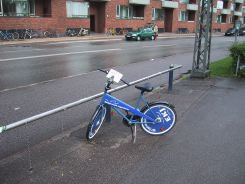
City Bike Stand with an available bike.
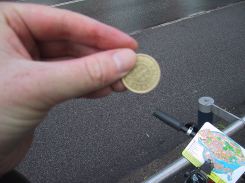
A 20 Kroner coin, the “key” to the bike.
Before you bother to “check out” the bike with your coin, give it a basic going over: check that there’s a chain and tires, check that the tires have air in them, check that the wheels are affixed to the bike and that the frame isn’t bent. These bikes take a beating, and I ran about 50% at getting a good bike during my week in the city.
Once you’re ready to proceed, insert the 20 Kroner coin into the bottom of the black orb attached to the handlebar post. What you’re trying to do is to pop out the metal clip on the top of the orb, so, depending on how all the components are fitting together, you may need to push and wiggle a fair bit. Eventually the metal clip should pop out, and the bike is yours.
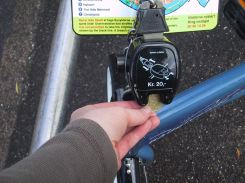
Insert the coin into the bottom of the orb.
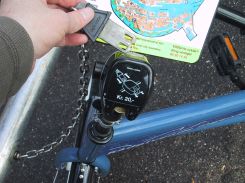
The metal clip should pop out.
Give the bike another run-through before you do any serious riding: look for wobbles, rattles, or anything else unusual.
Before you head out, note the boundaries of the City Bike area on the map that’s mounted on the front of the bike: this shows you where you’re allowed to ride the bike (there are rumours of steep fines for “violators”).
You’ll find Copenhagen a very bike-friendly city, with special bicycle lanes on most streets, and special bike traffic signals at most intersections. And you’ll find lots of fellow cyclists out riding, which, if you don’t live in a bike-friendly city, takes some getting used to. Watch what other cyclists are doing to get a handle on the routines for stopping, making left turns, passing and so on.
When you want to stop and get off the bike for a while you have two choices. If you’re not near a City Bike stand, you risk someone leaving with your bike, either to ride it somewhere else, or to use it to retrieve the 20 Kroner coin. If you’re near a City Bike stand you can “return” the bike, retrieve your coin, and return later, gambling that your (or another) bike will be ready for you.
The greatest thing about the City Bike program over renting a bike, other than price, is that you can get a bike where and for as long as you need it. For example I got up in the morning, grabbed a City Bike, rode downtown, left the bike walked around, ending up down at the harbour ferry, sailed up the harbour, grabbed another bike, parked the bike and visited a museum, grabbed another bike and rode back downtown, where I took the Metro back to my hotel.
A quote from a nutritionist in the BBC television series Food on the Brain:
Part of our body today is yesterday’s lunch.
Perhaps because I’d just eaten a slice of Air Canada’s cheese-like pizza, that hit home. The series is well worth a watch if you can find it: they follow three teens with various learning, behaviour and social problems through nutritional testing followed by a dramatic change in diet (i.e. no longer drinking 4 large bottles of soda every day), followed by a “did their change in diet affect their problems” analysis.
There’s for-fee WiFi throughout Copenhagen Airport. As of this writing (June 2005) it’s 60 Kroner ($12.00 Canadian) for an hour’s worth, and you can pay with credit card (just open your browser and visit any site; you’ll get auto-redirected to the payment gateway and can proceed from there). An excellent place to use the WiFi is the “transfer lounge.” It’s quite, there are free power outlets and desks with chairs, and it’s right in the middle of the departure terminal.
Of course you can also use a luggage cart.
If you’re staying at the CAB Inn Scandinavia in Copenhagen, and need to get to/from Kastrup airport, there’s a really easy way to do it, a way that avoids the crowded downtown Central Station and any need to walk long distances, or take cabs or buses.
From the airport to the hotel: At the far end of the arrivals terminal buy a “3 zone” transit ticket, either from the machines or from the wickets; at this writing the cost is 25,50 Kroner. Go downstairs and catch the Copenhagen (København) bound train. Don’t go all the way into the city, however: get off at Ørestad. Walk upstairs and get on a Vanløse-bound Metro. You don’t need a new ticket, as your “3 zone” ticket for the train is still in effect. Stay on the Metro through to the Forum stop and get off. Walk upstairs. As you exit the Forum Metro station keep walking straight ahead in the same direction along the main street you emerge on; half a block later, just after the statue of three green men, turn right. CAB Inn Scandinavia is 1/2 block ahead on the right, very obvious. The entire trip, assuming good connections, will take you 30 minutes airport to hotel.
From the hotel to the airport: At the hotel make sure you have 25,50 Kroner in change; if not, ask at reception and they will help. Walk out of the hotel and go to the left. At the main street, in front of the statue of the three green men, turn left. Just ahead you will see the Forum, with the Forum Metro station in front. Walk to the station. Take the stairs down one level and buy a “3 zone” ticket from the machine, at this writing it’s 25,50 Kroner. Walk down to the platform and get on a Vestamager-bound Metro. Ride the Metro to the Ørestad station. Get off and walk to the end of the platform (away from the large Field’s shopping mall) and down to Track 1 of the train platform below. You don’t need a new ticket, as your “3 zone” ticket for the train is still in effect. Catch any train bound for Kastrup airport; there are helpful video displays at the track that show upcoming trains. The train to the airport takes about 8 minutes. Total trip, assuming good connections, will take you about 30 minutes, hotel to airport.
Note: at some point in the future, the Metro will be extended all the way to Kastrup, making this an even simpler transit. Watch the Metro website for updates.
It’s a beautiful day in Copenhagen — sunny, warm. Sad to leave. I’ve found a great way to get to the airport from the hotel that I’m going to try out. If it works, I’ll get there in a flash, it will only cost me 25 Kr. and I’ll avoid all the crowds downtown. If it doesn’t work, I’ll miss my plane. Wish me luck.
Update: It worked! Here’s how.
Today was my last day in Copenhagen, and I succeeded it jamming in packed full of whacky exploits.
Nikolaj, Doc and Ben were gracious enough to extend an invitation to join them on a trip out into the Danish countryside for the morning. So at 9:00 a.m. we all piled into Nikolaj’s 1982 Mercedes, and headed out into the rainy streets of Copenhagen. Our first stop was one of the fantastic Danish coffee shops, places that raise the art of sitting down, taking a break and having a hot drink to a tantric art. The Danes make hot chocolate by placing a hunk of solid dark chocolate molded to the end of a stick into a cup full of steaming hot milk; the effect is completely unlike the powdered stuff I’m used to at home: thick, hot, not too sweet, slightly tart. Kind of like drinking a labrador retriever, but without all the hair.
Next, as Doc details here, we drove over to Dyrehaven for “walk in the woods.” Although it was raining, it was never enough to soak us through, and it was nice to be out and around in the fresh air after four or five days of conference rooms and hotels. The giant deer were an added bonus.
Back into the Mercedes, we drove up to Louisiana, a modern art gallery north of Copenhagen. We were rushing by this point, so we didn’t get a thorough tour of the site, but I got enough of a taste to know I’ll go back: classic Danish design, interesting art, and a very, very good chicken salad for lunch beside a roaring fire in a beautiful fireplace.
Ben had to be at the airport for a late afternoon flight, so Nikolaj dropped me downtown (with Doc’s umbrella in hand, a generous and completely necessary lend, as the rain was tumbling down by this point).
I wandered around downtown, found some secret well-design Danish goods for Catherine’s upcoming birthday (don’t tell Catherine), and then decided to take the Metro south to Field’s, a new shopping mall in the new planned community of Ørestad. I went both because I had a little more shopping to do, and because I wanted to see if, in addition to everything else, the Danes have found a way of making shopping malls beautiful. They have.
Ørestad is very close to the ØresundBridge, a bridge and tunnel construction, now five years old, that runs from Denmark to Sweden. It can be considered the sort of Nordic version of our own Confederation Bridge. Except that the speed limit is 110 km/h on ØresundBridge (instead of our pokey 80 km/h), there are high speed trains running over the ØresundBridge, and when you get to the other side the delights of Sweden await rather than, well, Greater Moncton.
How could I be so close and not pop over to Sweden for dinner?
This was easier said than done. Much of Copenhagen’s rail ticket buying infrastructure is automated, and the machines require either coins or a credit card with a PIN number. I had neither. After lots of futzing around with an ATM machine and a kindly change-offering merchant, I was in business. Thirty-five minutes later I was sitting down to a tasty meal at Indianside in downtown Malmö.
After dinner I tried to take photos of the Turning Torso, the intriguing new skyscraper rising up over the city (there’s a great Discovery Channel special on its construction; see it if you’re interested in tall buildings). Alas it was both too far away, and too blocked by the buildings downtown. I’ll have to go back.
Forty-five minutes later, I walked into my hotel here in Copenhagen.
Good day.
Back to Canada tomorrow via Frankfurt and Montreal; leaving here early, back on the last flight from Montreal tomorrow night.
I am at heart a very shy person. My shyness is selective though: while some people are terrified at the thought of speaking in public, I revel at the opportunity, and am comfortable in front of any sized audience. It’s being in the audience that terrifies me.
I don’t mean the “sitting on the hard chair, listening to the speakers” part of being in the audience. I mean the “hanging out in the coffee room after the speakers” part. I’m just no darned good at “working a room,” and I get so flummoxed by the prospect that I often fade into the silent background.
Partly this is because I’ve not got a good backstory. I can’t say “I manage the user interface design for Microsoft Word” or “I invented spray-on underwear lubricant.”
I am an easily distracted generalist, good enough at a wide range of things, expert at none; I’ve never been able to focus for long enough, or to tolerate the overlords implicit in a “position” to acquire a good title.
So my self-description is left to something like “well, I make websites and I’m a programmer and I’ve got these clients, and I blog and podcast, and sometimes I go on the radio, and I used to be a typesetter.” Not compelling stuff, I imagine.
Catherine has the same problem: she’s a weaver, a jeweler, a metal-smith, a spinner, a painter. Sometimes she says she’s an “artist,” sometimes a “craftsperson,” and sometimes she just says “I make things.” But she’s not shy.
Another cause: I don’t have an innate “small talk” ability. I love small talk — I could talk about the weather and the Blue Jays forever given the right conditions — but I’ve had to learn it from scratch, so it’s more an awkward second language than a fluent dialect.
And of course I’m just plain afraid. Terrified of the unknown, suddenly left frozen at the thought of freeform social contact.
Given that the interesting part of conferences happens during the “hanging out in the coffee room after the speakers” part, this fear / awkwardness / terror leaves me at something of a disadvantage.
Halfway through reboot, I decided that, fuck it, I had to just jump off. Pretend I wasn’t terrified, and see what played out.
I went down to the “sign up for dinner out with the people you’ve met” list by the door, choose a group at random, and put down my name (previous plan: cower back to my hotel). Then I figured out a way to get a ride to dinner, and even hung out with some rebootkins before dinner by pulling up a chair and chiming in. I even sat down for a brief chat with Scoble.
Much to my complete surprise, it worked.
I ended up at Cofoco with a great group of people: Nikolaj, Mark, Dragos, Bernhard, Thomas, Felix, Stefan, Henriette and a whole other bunch of people down the other end of the table.
And I didn’t explode or die or (I think) make a fool of myself. It was fun. I learned a lot (and had a great meal).
And the fun just kept on coming. Today I got invited out to dinner with Doc, Nikolaj and his wife and kids, Laurent and Ben. No explosions or deaths there either.
I think I will stop being shy now; it’s obviously worn out its usefulness.
Here’s another neat Plazes feature: a plug-in for web pages that grabs your current Plazes location, sticks it on a map, and returns a chunk.
(Since the demise of Plazes, this obviously no longer works; I’m leaving this post here for posterity).
Steven found this photo taken at the reboot meetup on Thursday. La-dee-dah — don’t I look all exotic and European with my glass of wine and my smirky look!
Yesterday I wrote about Plazes, a neato “geosocial” service. Tonight I saw it work in the real world.
At about 1:00 a.m. I was just finishing up on the late-nite blogging and email checking when a new email came in:
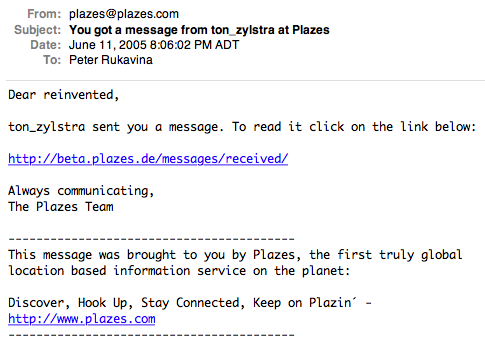
So I did was I was told, and clicked on the link, which took me to:
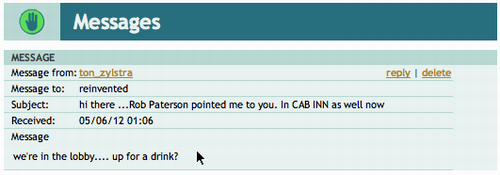
Ton found me originally because (a) Rob Paterson (big in Europe) told him to watch out for me and (b) because his Plazes told him I was here:
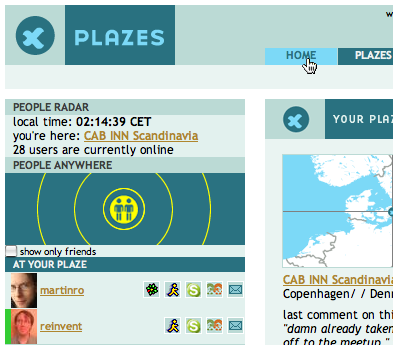
So I replied:
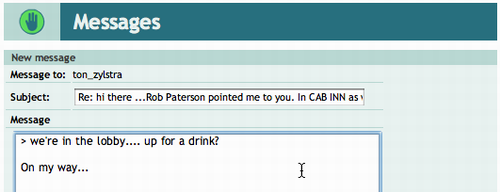
…and got dressed, went out to the lobby, and found Ton and Martin having a drink. I grabbed a hot chocolate, sat down, and we talked for over an hour about everything from Robert Scoble to making open source bread and open source cars, to just what all those people with laptops open during presentations at reboot were doing.
So Plazes was a social prosthetic device that (relatively) effortlessly enabled a conversation to happen that otherwise never would have.
By lucky coincidence I ended up crammed into the back of a Mercedes with Stefan Kellner and Felix Petersen — the “Plazes guys” — tonight on the way to dinner. They’re thoughtful, intelligent guys, but they’re otherwise completely normal. I think one of the most useful roles of conferences like reboot is to expose easily star-struck and meek people like me to thoughtful, intelligent people with brilliant projects like Plazes who happen to be otherwise completely normal: it makes it seem possible that, with some work, we too could become thoughtful and intelligent.
 I am
I am